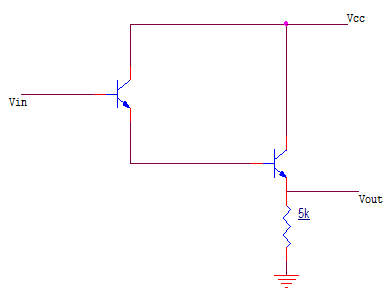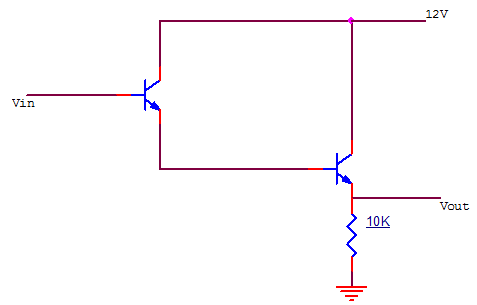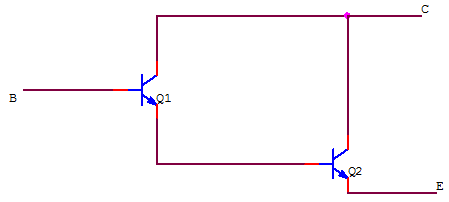1. The lower and upper cutoff frequencies of an amplifier are unknown. If originally, individual BW of such an amplifier is B1, and now the bandwidth of the cascaded network of 10 such amplifiers is B2, find B2/B1.
a) 0.26
b) 3.84
c) Insufficient data
d) 5
Explanation: To calculate net bandwidth B2 = B1 x \(\sqrt{2^{1/N}}-1\)
B2/B1 = \(\sqrt{2^{1/N}}-1\)
B2/B1 = 0.26
2. Provided a cascade multistage amplifier network, their pole frequencies obtained are f1=10Mhz, f2=12Mhz, f3=20Mhz, f4=16Mhz. What is the approximate higher cutoff frequency of the cascaded network?
a) 3.4 Mhz
b) 8 Mhz
c) 5 Mhz
d) 6 Mhz
Explanation: The net frequency
1/fH = 1/f1 + 1/f2 + 1/f3 + 1/f4 and so on for multiple stages.
1/fH = 0.295833
fH ≈ 3.4 Mhz.
3. Which of these are incorrect about Darlington amplifier?
a) It has a high input resistance
b) The output resistance is low
c) It has a unity voltage gain
d) It is a current buffer
Explanation: A Darlington amplifier has a very high input resistance, low output resistance, unity voltage gain and a high current gain. It is a voltage buffer, not a current buffer.
4. Consider the circuit shown below where hfe=50.
Calculate the input resistance of the network.
a) 255 kΩ
b) 13 MΩ
c) 5 MΩ
d) 250 kΩ
Explanation: The load for the first transistor in the figure is the input resistance of the second.
RE1 = (1+hfe)5k = 255kΩ
Net input resistance, RI = (1+hfe)RE1=(1+hfe)25k = 13005k = 13MΩ
5. Given the following circuit.
It is given that hfe=55, hie=1kΩ, hoe=25μΩ-1. Calculate the net current gain and the voltage gain of the network.
a) AI=192.6, Av=220
b) AI=1, AV=220
c) AI=192.6, AV=1
d) AI=192.6, AV=55
Explanation: AI=A1xA2
AI = [1+hfe/1+hoehfeRE]x[1+hfe].
AI = 51×51/(1+25x50x10x10-3) = 192.6.
6. In a Darlington pair, the overall β=15000.β1=100. Calculate the collector current for Q2 given base current for Q1 is 20 μA.
a) 300 mA
b) 298 mA
c) 2 mA
d) 200mA
Explanation: IB = 20 μA
IC = β.IB = 15000 x 20μ = 300 mA
IC1 = β1.IB = 100.20μ = 2mA
IC2 = 300 – 2 = 298mA
7. Darlington amplifier is an emitter follower.
a) True
b) False
Explanation: Darlington pair is an emitter follower circuit, in which a darling pair is used in place of a single transistor. It also provides a large β as per requirements
8. What is the need for bootstrap biasing?
a) To prevent a decrease in the gain of network
b) To prevent an increase in the input resistance due to the biasing network
c) To prevent a decrease in the input resistance due to the presence of multiple BJT amplifiers
d) To prevent a decrease in the input resistance due to the biasing network
Explanation: A bootstrap biasing network is a special biasing circuit used in the Darlington amplifier to prevent the decrease in input resistance due to the biasing network being used. Capacitors and resistors are added to the circuit to prevent it from happening.
9. Consider a Darlington amplifier. In the self bias network, the biasing resistances are 220kΩ and 400 kΩ. What can be the correct value of input resistance if hfe = 50 and emitter resistance = 10kΩ.
a) 141 kΩ
b) 15 MΩ
c) 20 MΩ
d) 200 kΩ
Explanation: R’ = 220k||400k = 142 kΩ
RI = (1+hfe)2RE = 26MΩ
RI’ = 26M||142k = 141.22 K
10. What is a cascade amplifier?
a) A cascade of two CE amplifiers
b) A cascade of two CB amplifiers
c) A cascade of CE and CB amplifiers
d) A cascade of CB and CC amplifiers
Explanation: A cascade amplifier is a cascade network of CE and CB amplifiers, or CS and CG amplifiers.
It is used as a wide-band amplifier